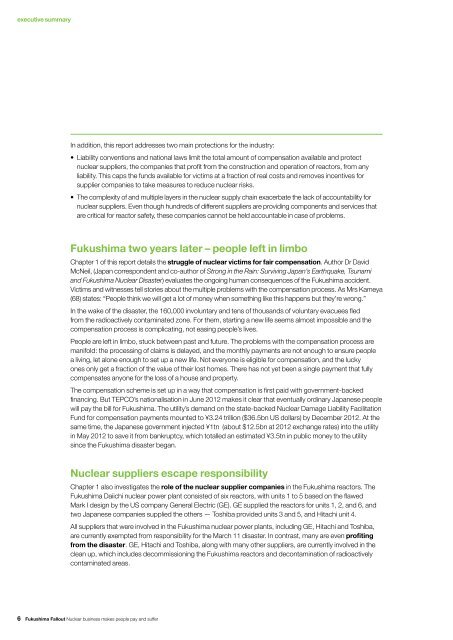Report: Fukushima Fallout | Greenpeace
Report: Fukushima Fallout | Greenpeace
Report: Fukushima Fallout | Greenpeace
Create successful ePaper yourself
Turn your PDF publications into a flip-book with our unique Google optimized e-Paper software.
executive summary<br />
In addition, this report addresses two main protections for the industry:<br />
• Liability conventions and national laws limit the total amount of compensation available and protect<br />
nuclear suppliers, the companies that profit from the construction and operation of reactors, from any<br />
liability. This caps the funds available for victims at a fraction of real costs and removes incentives for<br />
supplier companies to take measures to reduce nuclear risks.<br />
• The complexity of and multiple layers in the nuclear supply chain exacerbate the lack of accountability for<br />
nuclear suppliers. Even though hundreds of different suppliers are providing components and services that<br />
are critical for reactor safety, these companies cannot be held accountable in case of problems.<br />
<strong>Fukushima</strong> two years later – people left in limbo<br />
Chapter 1 of this report details the struggle of nuclear victims for fair compensation. Author Dr David<br />
McNeil, (Japan correspondent and co-author of Strong in the Rain: Surviving Japan’s Earthquake, Tsunami<br />
and <strong>Fukushima</strong> Nuclear Disaster) evaluates the ongoing human consequences of the <strong>Fukushima</strong> accident.<br />
Victims and witnesses tell stories about the multiple problems with the compensation process. As Mrs Kameya<br />
(68) states: “People think we will get a lot of money when something like this happens but they’re wrong.”<br />
In the wake of the disaster, the 160,000 involuntary and tens of thousands of voluntary evacuees fled<br />
from the radioactively contaminated zone. For them, starting a new life seems almost impossible and the<br />
compensation process is complicating, not easing people’s lives.<br />
People are left in limbo, stuck between past and future. The problems with the compensation process are<br />
manifold: the processing of claims is delayed, and the monthly payments are not enough to ensure people<br />
a living, let alone enough to set up a new life. Not everyone is eligible for compensation, and the lucky<br />
ones only get a fraction of the value of their lost homes. There has not yet been a single payment that fully<br />
compensates anyone for the loss of a house and property.<br />
The compensation scheme is set up in a way that compensation is first paid with government-backed<br />
financing. But TEPCO’s nationalisation in June 2012 makes it clear that eventually ordinary Japanese people<br />
will pay the bill for <strong>Fukushima</strong>. The utility’s demand on the state-backed Nuclear Damage Liability Facilitation<br />
Fund for compensation payments mounted to ¥3.24 trillion ($36.5bn US dollars) by December 2012. At the<br />
same time, the Japanese government injected ¥1tn (about $12.5bn at 2012 exchange rates) into the utility<br />
in May 2012 to save it from bankruptcy, which totalled an estimated ¥3.5tn in public money to the utility<br />
since the <strong>Fukushima</strong> disaster began.<br />
Nuclear suppliers escape responsibility<br />
Chapter 1 also investigates the role of the nuclear supplier companies in the <strong>Fukushima</strong> reactors. The<br />
<strong>Fukushima</strong> Daiichi nuclear power plant consisted of six reactors, with units 1 to 5 based on the flawed<br />
Mark I design by the US company General Electric (GE). GE supplied the reactors for units 1, 2, and 6, and<br />
two Japanese companies supplied the others — Toshiba provided units 3 and 5, and Hitachi unit 4.<br />
All suppliers that were involved in the <strong>Fukushima</strong> nuclear power plants, including GE, Hitachi and Toshiba,<br />
are currently exempted from responsibility for the March 11 disaster. In contrast, many are even profiting<br />
from the disaster. GE, Hitachi and Toshiba, along with many other suppliers, are currently involved in the<br />
clean up, which includes decommissioning the <strong>Fukushima</strong> reactors and decontamination of radioactively<br />
contaminated areas.<br />
6 <strong>Fukushima</strong> <strong>Fallout</strong> Nuclear business makes people pay and suffer

















